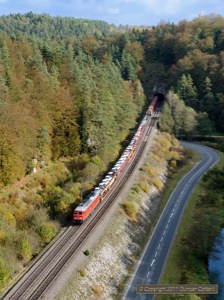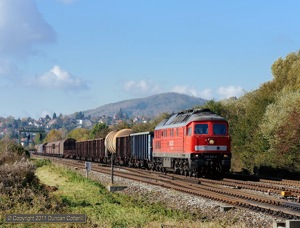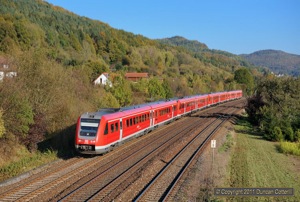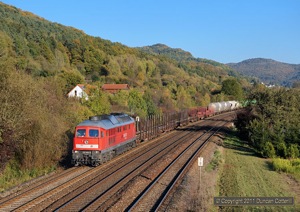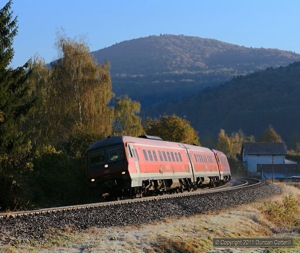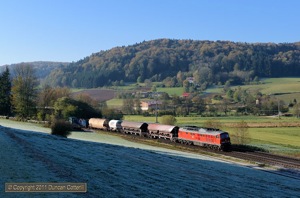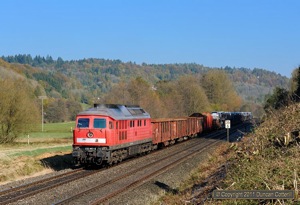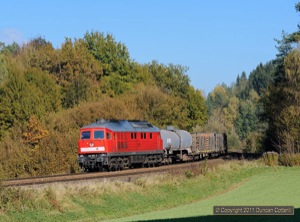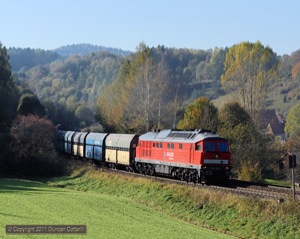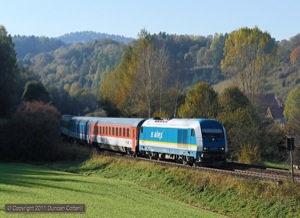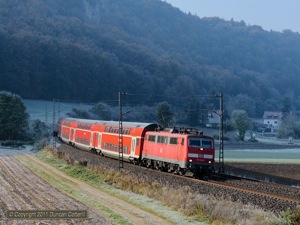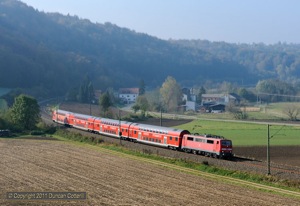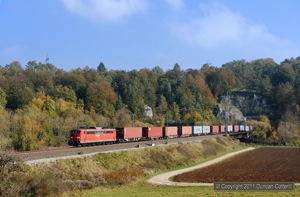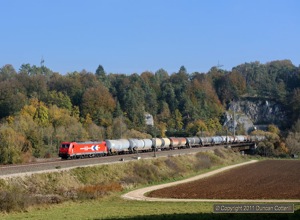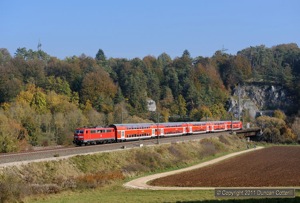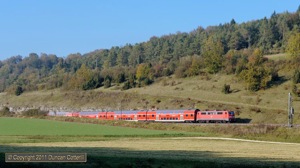Return to the Ludmilla Triangle
19 - 23 October 2012
Report by Duncan Cotterill
Introduction
I’d had a brief look at the class 232 hauled freights on the scenic diesel worked lines north and east of Nürnberg in September and decided there was more than enough potential to justify a return visit. When the opportunity for a five day trip arose in late October, there was no difficulty in deciding where to go. I flew from Gatwick to Nürnberg with Air Berlin then hired a car to get around.
This section of the report summarises what was seen. For train by train details with loco numbers etc, go to the Day by Day pages.
The Lines
Four days were spent at the west end of the triangle on KBS 860 from Nürnberg to Hof and KBS 870 from Nürnberg to Schwandorf. The third side of the triangle, KBS 855 from Regensburg to Hof has less booked freight traffic and wasn’t visited.
KBS 860 leaves Nürnberg and runs east to Hersbrück (km 27.7 from Nürnberg) along the north side of the Pegnitz valley. Several stations on this line have the suffix “rechts Pegnitz” to distinguish them from stations on the parallel “links Pegnitz” route on the south side of the river. At Hohenstadt (km 33.4) the line turns sharply north and follows the Pegnitz valley into the hills. North of Vorra (km 39.8) the valley narrows and from Rupprechtstegen (km 44.5) to just north of Velden (km 47.6) it cuts a straight line through a narrow, winding gorge using a succession of bridges and tunnels to shortcut the twists and turns of the river. The landscape opens out again by Neuhaus (km 50.7). The section beyond Neuhaus through Kirchenlaibach (km 93.7) and Marktredwitz (km 124.2) to Hof has yet to be explored.
KBS 870 is a bit of a hybrid. The original route of the Bavarian Eastern Railway follows the south side of the Pegnitz from Nürnberg to Hersbruck (links Pegnitz) (km 28 from Nürnberg) then continues along the valley of the Högenbach to Hartmannshof (km 37), where it turns north and follows the Etzelbach to a summit near Neukirchen (km 45.1). A branch from Neukirchen heads north-eastwards to Weiden on the Regensburg - Hof line. The main line leaves Neukirchen in a south-easterly direction then drops through Sulzbach-Rosenberg (km 55.2) and Amberg (km 67.1) to a junction with the Regensburg - Hof line at Irrenlohe (km 89.3), 4 km north of Schwandorf. Today’s KBS 870 uses the “rechts Pegnitz” route to Hersbruck then takes a single track connecting line across the valley from Hersbruck Ost (km 29.2) on the “rechts Pegnitz” line to Pommelsbrunn (km 32.3) on the “links Pegnitz” line. The original “links Pegnitz” route from Nürnberg through Pommelsbrunn to Hartmannshof has been electrified and now forms the eastern end of Nürnberg’s S-Bahn Line 1.
Passenger Trains
The only loco hauled passenger trains on either KBS 860 or 870 are three pairs of ALEX services that run between Nürnberg Hbf and Schwandorf via Hersbruck (rechts Pegnitz). Two pairs of trains run from Nürnberg to Praha and v.v. via Domazlice and Plzen, while the third is basically a positioning move to get a train from Schwandorf to Nürnberg in the early morning and to return it to Schwandorf in the late evening. These trains are easy to identify in the timetable as their numbers are prefixed by “ALX”. They’re easy to identify on the lineside as well, being formed of blue, white and yellow ALEX liveried class 223 locos on trains of either ALEX or CD stock. Locos 223 064/067/071/072 were seen.
There are frequent RegioExpress services on both lines. The basic service on line 860 is an hourly RE from Nürnberg to Pegnitz, where it splits. One portion runs to Bayreuth while the other continues to one of several possible destinations including Cheb in the Czech Republic, Kirchenlaibach or Dresden. There is also a 2-hourly IRE service from Nürnberg to Dresden via Bayreuth. Anything to or from Dresden is formed of two, or sometimes three, class 612 units while trains to or from other places are more likely to be formed of class 610 units. No mixed formations were seen, presumably classes 610 and 612 have incompatible control systems despite having auto-couplers that appear to be identical.
The basic service on line 870 is an hourly RE from Nürnberg via Hersbruck (rechts Pegnitz), Neukirchen and Weiden to Neustadt(Waldnaab) and an hourly RE from Nürnberg via Hersbruck (rechts Pegnitz) and Neukirchen to Schwandorf with some services continuing to Regensburg. At quieter times both trains run combined as far as Neukirchen but at busier times they sometimes run as individual trains. Most trains are worked by class 610 DMUs with some class 612s and the occasional class 628 also appearing.
There is also an hourly RB all-stations service from Nürnberg to Neuhaus on KBS 860, worked by class 648 DMUs. All I saw of the Nürnberg - Hartmannshof S-Bahn operation was a distant view of an EMU, possibly a class 423.
Freight Traffic
Class 232 hauled freights are undoubtedly the area’s main attraction and there were a reasonable number of trains to photograph on most days. As I noted in my September report, trains on the Schwandorf line tended to be reliable runners, usually showing up close to their booked times, while those on the busier Hof line ran a bit more erratically. Individual schedules were obtained from https://www.cargonautus.de/ and proved to be invaluable, allowing the majority of workings to be positively identified.
Freights bound for the Schwandorf line can be booked to run via the “rechts Pegnitz” main line or via the “links Pegnitz” S-Bahn line. Everything I saw appeared to follow it’s booked route while additional trains tended to take the “rechts Pegnitz” line. The standard weekday pattern was a morning eastbound (Hartmannshof 09:30) and two afternoon westbounds (15:30 and 16:10) but there were also a few extras including an early afternoon train of PKP coal hoppers that appeared at the same time on two different days, so may be semi-regular. Very few freights are scheduled to run at weekends.
The situation on KBS 860 is much more variable with a slightly different traffic pattern every day. Traffic is heaviest from Wednesday to Friday with Tuesdays and Saturdays quieter and Sundays and Mondays very quiet indeed. Regular trains on the busier days include a procession of 3 or 4 freights from Nürnberg between 08:20 and 13:20 (at Hersbruck) followed by a long gap until around 18:00. Southbounds are less frequent with regular trains due at Hersbruck at 08:40 and 13:40. On Thursdays there’s an additional train at 16:30. There were additional trains on this line as well with one or two southbounds often preceding the booked lunchtime train.
All the freights seen were hauled by Ludmillas with only two class 233s breaking the class 232 monopoly. Locos 232 252/330/384/388/457/461/571/589/609/618/654, 233 306/511 were seen.
Photography
October was a great time to visit the line for autumn colours but not for the light. Many locations that were well lit for several hours in September never emerged from the shadows in late October. Fortunately there were more than enough good spots to keep me busy for the five days I was there. If there hadn’t been, I had the option of going further north on line 860 or further east on line 870 but never found the time. The weather was mixed but got progressively better as the trip went on. The first two days produced only one good shot but the last two days were much more productive with clear skies from lunchtime on the Friday and all day Saturday.
KBS 990 Treuchtlingen - Ingolstadt
Freight traffic east of Nürnberg is sparse on Sundays so I travelled south to the electrified Treuchtlingen - Ingolstadt main line where there were regular loco worked passengers and a few freights as well. This scenic line is described in my April 2010 report.
As expected, the hourly Regio passenger service was worked entirely by class 111s on double-deck push-pull sets. Unusually for Germany, the trains run with the loco at either end, seemingly at random. On this occasion around 75% of the locos were at the Ingolstadt (east) end of the trains, which helped in the morning but made things more difficult in the afternoon.
Freight traffic wasn’t heavy but it was a Sunday and five freights in seven hours was around the expected level. Curiously all five were westbounds and three of the five were trains of cars. There was also a set of four RTC electrics (Classes 186 and 189) going west light engine and a DB 363 going east with an inspection coach. Three of the freights were hauled by DB power, a 151, a 152 and a 155, the first on containers and the other two on car-carriers. The other trains were an HGK 185 on oil tanks and an RTC 185 double heading a Wiener Lokalbahn 183 on cars.
The weather was generally good following a misty start, with clear blue skies marred only by a few clouds.
Comments and Conclusions
Despite the dull, wet start, the trip still produced a number of good pictures and sowed the seeds for future trips to the area east of Nürnberg. With the threat of electrification hanging over the Nürnberg - Hof line and the risk of class 266 (66) taking over, there are likely to be quite a few return trips in the next year or so. After the fall of Mühldorf this must be the best place left to photograph diesel hauled freight in Germany, if not all of Europe outside the former USSR. There may be busier places but the combination of reasonably heavy traffic, photogenic locos and attractive scenery takes some beating.
The combination of hourly stopping services and relatively short distances between stations would have made it relatively easy to get about by train. All the spots I visited were within reasonable walking distance of a station. The biggest advantage of having a car was the ability to move easily from one line to the other and back again to take advantage of the different traffic patterns on each line.
